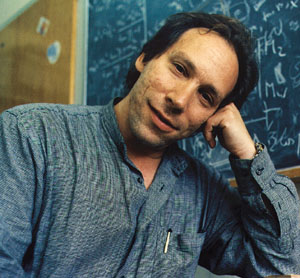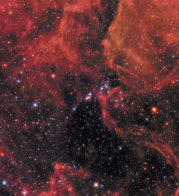Neutrinos created in the first seconds after the Big Bang could hold vital clues about the evolution of the universe. A workshop in Trieste looked at a wealth of intriguing possibilities.

Neutrinos are probably one of the most abundant components of the universe. As well as the 3K microwave background radiation, the universe is filled with a sea of relic neutrinos that decoupled from the rest of the matter within the first 10 seconds after the Big Bang. These relic neutrinos may have played a crucial role in nucleosynthesis, structure formation and the evolution of the universe as a whole. They may also contain clues about baryogenesis the formation of nuclear matter.
Relic neutrinos, their role in Nature and their possible manifestations were the focus of a workshop entitled the Physics of Relic Neutrinos, which was organized at the Abdus Salam International Center for Theoretical Physics (ICTP) in Trieste, Italy, last September by ICTP and the Italian INFN.
A non-zero neutrino mass can dramatically change the properties of the relic neutrino sea and its role in the evolution of the universe. A special session looked at the evidence for neutrino masses and consequent mixing from the studies of atmospheric and solar neutrinos. E Lisi (Bari) showed that all data on atmospheric neutrinos (including the latest SuperKamiokande data and the old results from Kamiokande) can be well described by maximal muontau neutrino oscillations with a squared mass difference of some 5 x 10-3 eV2.
Muon neutrino oscillations into non-interacting “sterile” neutrinos can also give a good fit of the data (O Peres, Valencia). A majority of alternative explanations of the atmospheric neutrino problem, like a neutrino decay, reviewed by S Pakvasa (Hawaii), still imply non-zero neutrino masses.
Although the solar neutrino data give a strong hint of neutrino mass we are still far from reaching a conclusion, and progress (in Lisi’s opinion) will be slow. Detailed studies of spectral distortions and possible time variations (L Krauss, Case Western) are needed to determine the neutrino parameters.
Neutrino mass spectrum
Reconstruction of the complete neutrino mass spectrum from present data is of great importance both for particle physics and cosmology, as discussed by M Fukugita (Tokyo), F Vissani (DESY) and R Mohapatra (Maryland). One of the most interesting recent suggestions is the bimaximal mixing scheme with degenerate neutrinos in eV mass range (Vissani). Attempts to accommodate all of the existing data and/or to explain large mixing lead to the introduction of sterile neutrinos (reviewed by Mohapatra). Their existence would have enormous consequences for astrophysics and cosmology (Z Berezhiani, Tbilisi).

Several talks looked at a possible relationship between properties of the relic neutrinos and baryogenesis. One of the favoured mechanisms (reviewed by E Roulet, La Plata) is an initial lepton asymmetry, converted to baryon asymmetry through electroweak sphalerons. (The electroweak vacuum has two topologically distinct classes. Sphalerons can connect these different vacua.)
The lepton asymmetry can be generated via the CP-violating decay of heavy (1010 GeV) right-handed neutrinos. W Buchmuller (DESY) has considered a supersymmetric realization of this possibility. A new mechanism of leptogenesis, via CP-violating oscillations of the right-handed neutrinos with masses 20-50 GeV and very small couplings, was described by E Akhmedov (ICTP). A Pilaftsis (Munich) discussed the enhancement of leptonic CP asymmetries in the decays of nearly degenerate TeV neutrinos. In all of these scenarios the lepton asymmetry is typically of the same order as the final baryon asymmetry. Through the “seesaw” oscillation mechanism these right-handed neutrinos naturally endow light neutrinos with masses in the range 10-3-1 eV, relevant for cosmology and for explaining the solar and atmospheric neutrino data. The leptonic asymmetry can also be produced without right-handed neutrinos in the decays of new triplet Higgs particles (U Sarkar, Ahmedabad).
The neutrino sea was crucial for Big Bang nucleosynthesis (BBN). The present status of the BBN “crisis” – inconsistent values of baryon-to-photon number densities implied by helium-4 and deuterium abundances was covered by G Steigman (Ohio). This issue is not yet settled, although recent studies indicate a larger He-4 abundance. The problem can be resolved if there were less than three light neutrino species at the time of nucleosynthesis. This can be realized, for example, if the mass of the tau neutrino is a few MeV and it decays with a lifetime of about 5 s (S Pastor, Valencia).
Another solution can be related to a significant leptonic asymmetry. The influence of the leptonic asymmetry on BBN was discussed by R Volkas (Melbourne), X Shi (San Diego) and D Kirilova (Sofia). The general principles of the creation of an asymmetry in oscillations of active to sterile neutrinos in a medium were presented by Volkas. A lepton asymmetry of some 10-5 produced at high temperatures may suppress the generation of the equilibrium concentration of sterile neutrinos in oscillations at low temperatures. This could reconcile a possible large mixing of active and sterile neutrinos (as indicated by the atmospheric neutrino data) with the BBN bound. For this to work, the heaviest neutrino has to be heavier than 15 eV (Shi). The production of a lepton asymmetry in neutrino oscillations after neutrino decoupling and its influence on He-4 abundance was discussed by Kirilova.
Structure formation
One of the central themes of the workshop was the role played by relic neutrinos in the structure formation of the universe. Recently the situation has changed dramatically. According to J Silk (Berkeley), no model fits the detailed shape of the power spectrum of density perturbations and satisfies all of the existing constraints. The cold + hot dark matter (CHDM) model with neutrinos contributing 0.2 to the critical (omega) parameter gives a better fit than other models. This implies a neutrino mass of about 5 eV and describes the nearby universe well, however (like the other models with (omega) = 1 and zero cosmological constant) it is disfavoured by data on early galaxies, cluster evolution and high redshift type IA supernova (J Primack, UC Santa Cruz). A good fit of both the nearby and distant data can be obtained with a cosmological constant and (omega) about 0.6, and the presence of large-scale inflationary relics like voids (Silk). As was underlined by Primack and M Roos (Helsinki), the presence of HDM is not necessary in this model, although some amount of HDM is still possible and may be useful for further tuning the data.
The situation can be clarified with new precision measurements of the cosmic background radiation anisotropy made by MAP and PLANCK, and by new galaxy surveys like SDSS. The latter will be sensitive to neutrino masses as low as 0.1 eV.
The properties of neutrinos and the relic neutrino sea are imprinted in the cosmic microwave background anisotropy. The observations by MAP and PLANCK will be sensitive to the effective number of neutrino species to an accuracy of 0.1, so it will be possible to test the existence of sterile (even non-equilibrium) neutrinos in the relic sea, neutrino decays (S Hannestad, Aarhus), and a possible neutrino degeneracy (discussed by S Sarkar, Oxford). Present data admit a rather strong degeneracy. A large lepton asymmetry can modify the history of the universe, leading, for example, to symmetry non-restoration. A large lepton asymmetry can be generated by neutrino oscillations or other mechanisms.
The evolution of the relic neutrino sea (clustering, formation of structures and so on) in the presence of neutrino masses or new interactions is of special interest. As was discussed by N Bilic (Zagreb), self-gravitating neutrino clouds can show “gravitational phase transitions” in the process of contraction and form neutrino stars, the scale of whose sizes would depend on the neutrino mass.
The properties of neutrinos and their reactions in extreme conditions very dense and hot media, and very strong magnetic fields are an important issue. These were considered by R Horvat (Zagreb), A Ioannisian (Munich) and D Grasso (Valencia).
Detecting relic neutrinos directly will of course be of fundamental importance, but it would seem to be impossible with present methods. However, we may be able to observe some indirect manifestations of the relic sea even now. D Fargion (Rome) and T Weiler (Vanderbilt) have considered the possibility that the highest energy cosmic rays detected on Earth may have been produced by the annihilation of ultra-high energy neutrinos with the neutrinos from the relic sea. This mechanism implies a neutrino mass of at least a few eV and the clustering of HDM near our galaxy. The relic sea could also be detected if neutrinos undergo a relatively fast radiative decay. Such a decay would explain the ionization of hydrogen in the universe. The present status of this hypothesis was summarized by D Sciama (Trieste). Direct searches for the 900 Å line from this radiative decay are now under way by the UV detector EURD, in orbit since April 1997, and results are expected soon.
Apart from the Big Bang relic neutrinos, the present universe must be filled with relic neutrinos from past supernovae (K Sato, Tokyo) or from collapses of supermassive objects with an energy spectrum in the range 150 MeV. Some contribution may also come from the evaporation of primordial black holes (E Bugaev, Moscow). The possibilities for detecting neutrinos from relic and real-time supernovae with existing and new underground neutrino detectors were discussed by D Cline (UCLA), who also described the new project for a supernova burst observatory, where neutrinos will be detected through secondary neutrons emitted by the recoiling nuclei.
The workshop revealed deep connections between a variety of fundamental open questions in cosmology, astrophysics and particle physics. In a sense it outlined a new field of research which has the goal of understanding the properties of the relic neutrino sea and its possible detection. This goal will be one of the challenges for the physics and astrophysics of the next millennium.





